Electricity: Magnetic and Heating Effects Chapter Notes | Science Class 8 PDF Download
Introduction
Have you noticed how a bulb lights up when you switch it on? But what if you don’t have a bulb—how else could you tell that electricity is flowing? Imagine being at an exciting science exhibition, just like Mohini and Aakarsh, and discovering that electric current can do things even a magnet can—not just create light, but also attract metals and produce heat!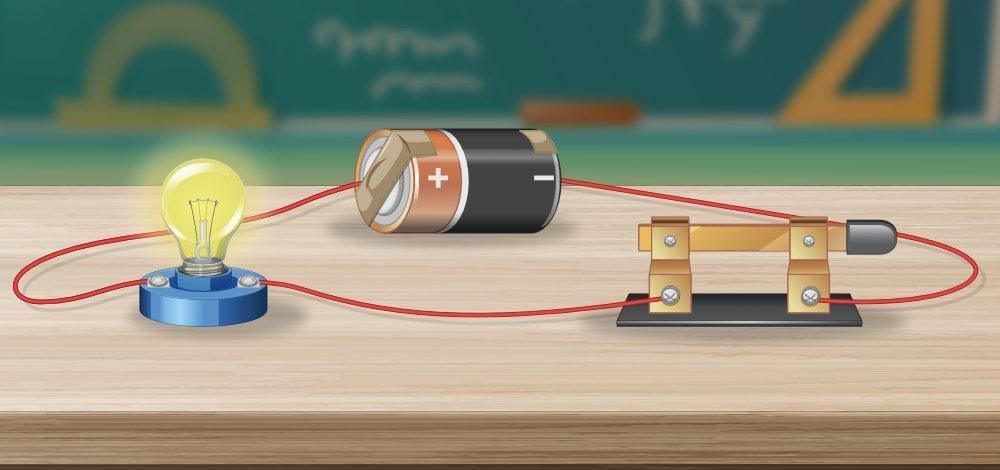 Electric Circuit
Electric Circuit
This chapter will help you explore the amazing things electricity can do beyond just lighting bulbs—like producing heat and creating magnetic forces. Let’s dive in!
Does an Electric Current Have a Magnetic Effect?
Magnetic Effect of Electric Current: When electric current flows through a conductor (like a wire), it produces a magnetic field around it. This is called the magnetic effect of electric current.
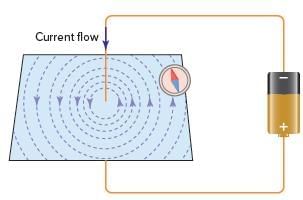 Electric Circuit and Magnetic Compass
Electric Circuit and Magnetic Compass
- Magnetic Compass: The presence of this magnetic field can be detected using a magnetic compass. When current flows, the compass needle is deflected; when current stops, the needle returns to its original direction.
- Magnetic field: The area around a magnet or current-carrying wire where its magnetic effect is felt (for example, by the deflection of a compass needle).
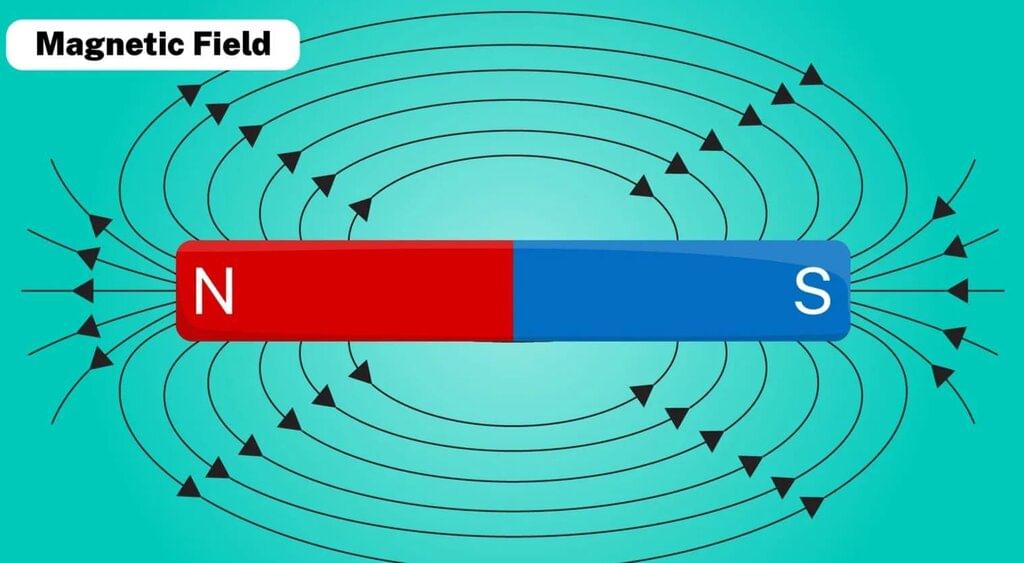
Discovery of Magnetic Effect by Oersted
- Hans Christian Oersted (1777–1851) discovered in 1820 that electricity and magnetism are linked. He found that when an electric circuit is switched ON or OFF near a magnetic compass, the needle deflects, showing that electric current creates a magnetic field.
- This discovery laid the foundation for understanding the connection between electricity and magnetism.
Electromagnet: Definition and Features
A current-carrying coil of wire wrapped around an iron core (like a nail) behaves as a magnet. Such a setup is called an electromagnet.
- Electromagnet: A soft iron core wound with a wire coil that produces a magnetic field only when electric current flows through it.
- The magnetism of the electromagnet disappears when the current is switched off.
How to Make an Electromagnet (from Activities):
- Wrap insulated wire around an iron nail to form a coil.
- Connect both ends of the wire to a cell.
- When current flows, the iron nail can attract iron objects.
- Disconnecting the current causes the nail to stop acting as a magnet.
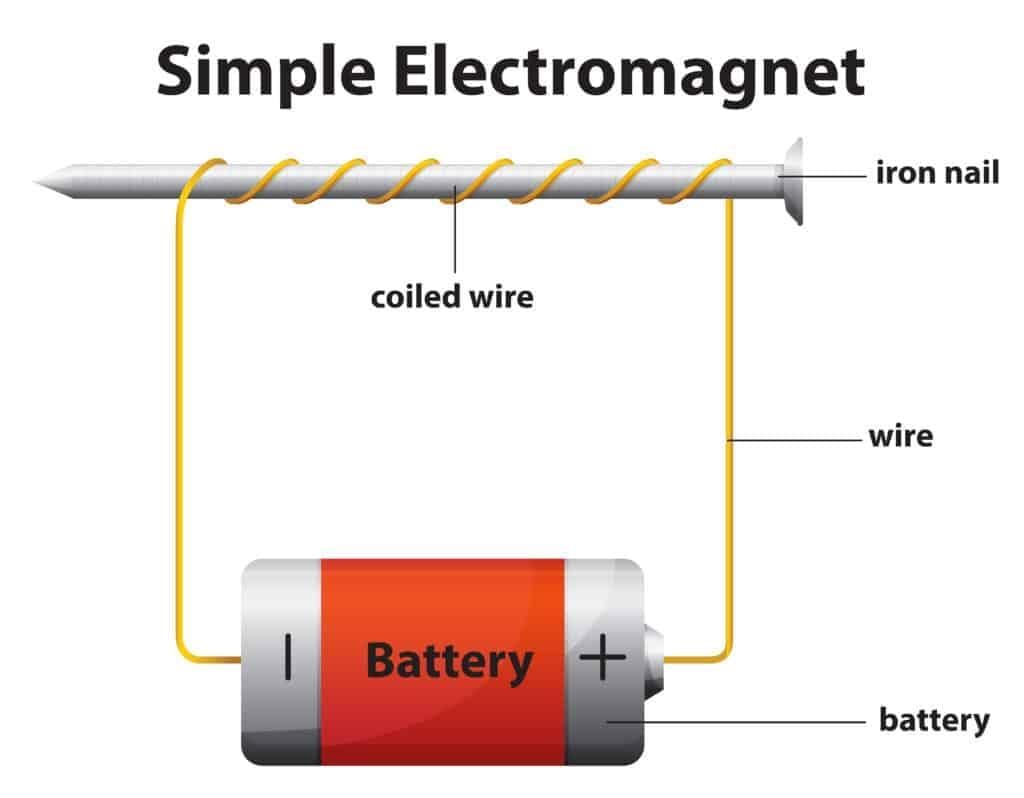 Strength and Polarity of Electromagnets
Strength and Polarity of Electromagnets
- Electromagnets have two poles (North and South), just like bar magnets.
- The poles can be determined using a magnetic compass.
- The polarity of the electromagnet reverses if the direction of the current is reversed.
 Compass Needle near end A and end B
Compass Needle near end A and end B
The strength of an electromagnet increases with:
- Greater current (using more cells/battery).
- More turns of wire in the coil.
- Inserting an iron core inside the coil.
Lifting Electromagnets
Lifting electromagnets are strong electromagnets used in cranes for lifting/moving heavy iron or steel objects. They are widely used in factories and scrap yards to move, lift, and sort heavy metal items efficiently.
 Lifting Electromagnets
Lifting Electromagnets
- Turning the current ON activates the magnet (lifts the metal).
- Turning the current OFF drops/releases the metal.
Earth’s Magnetic Field
- Earth acts as a giant magnet due to the movement of liquid iron in its core, which creates electric currents and generates a magnetic field.
- Many migratory birds, fish, and animals use the Earth's field to navigate.
- The Earth's magnetic field also shields life on Earth from harmful particles from space.
Does a Current-Carrying Wire Get Hot?
- Observation: When electric current flows through a conductor (like a nichrome wire), the wire becomes warm or even hot.
- Reason: This happens because the conductor resists the flow of electric current. This resistance causes some electrical energy to turn into heat energy.
- Heating Effect of Electric Current: The warming up of a conductor due to passage of electric current is called the heating effect of electric current.
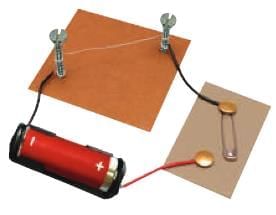 Heating Effects in a Wire
Heating Effects in a Wire
What is Resistance?
Resistance is the property of a material that opposes the flow of electric current. Different materials offer different resistance:
- Nichrome wire has high resistance and gets heated more than a copper wire of the same size.
The amount of heat produced depends on:
- Type of material.
- Thickness and length of the wire (longer and thinner wires heat up more).
- The strength of the electric current (more cells = more current = more heat).
- Time duration for which current flows.
Everyday Examples of Heating Effect of Electric Current
- Applications: Many appliances work on the heating effect of electric current because they contain a wire element made of nichrome or similar material.
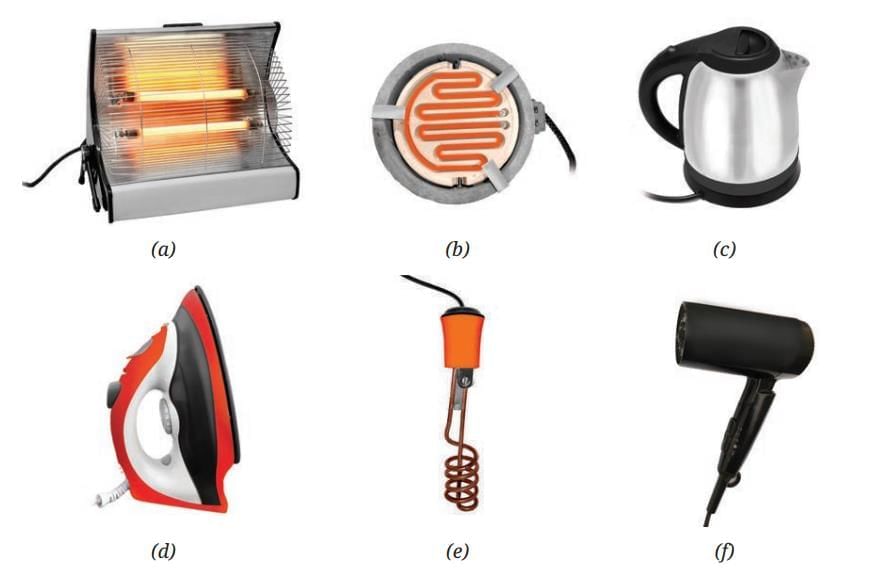 Household Electrical Appliances
Household Electrical Appliances - Examples: Electric room heaters, electric stoves, irons, immersion rods, kettles, hair dryers, and incandescent lamp filaments.
- In some devices, the heating element becomes red-hot and may even glow.
Safety Measures
- Wires and appliances can overheat if too much current flows, which may cause damage, melting, or even fires.
- Use wires, plugs, and sockets rated for the correct amount of current. Install safety devices in household wiring to prevent overheating.
Industrial Uses
- High-temperature electric furnaces are used in industries to melt and recycle steel.
- These furnaces rely on the heating effect of a large electric current flowing through special heating coils.
Advantages and Disadvantages of the heating effect of electric current
- Advantage: The heating effect is useful for many daily and industrial tasks.
- Disadvantage: It sometimes leads to energy loss and overheating of wires, which is wasteful or dangerous.
How Does a Battery Generate Electricity?
What is an Electric Cell?
- An electric cell is a device that produces electricity through a chemical reaction.
- Cells have two terminals (positive and negative), which can be connected in a circuit to supply electric current.
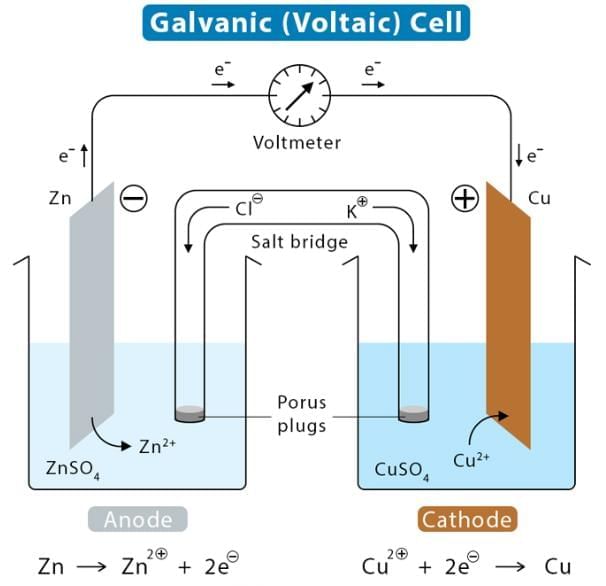
Voltaic Cell (Galvanic Cell)
One of the earliest electric cells, also called a Voltic or Galvanic cell.
- It has two different metal plates (electrodes) partly immersed in an electrolyte (a liquid that can conduct electricity).
- The chemical reaction between the metals and the electrolyte releases energy in the form of electricity.
- Electric current flows from the positive terminal (one metal) to the negative terminal (other metal) through the circuit.
- After some time, the materials inside are used up; the cell stops working and is called a dead cell.
Origin of the Voltaic Cell
- Alessandro Volta and Luigi Galvani studied how electricity could be produced using metals and liquids.
- Volta demonstrated that electricity was generated from the combination of different metals and an electrolyte, not from living things.
Making a Simple Cell (Lemon Battery Activity)
You can make a simple electric cell at home using a lemon, a copper strip/wire, and an iron nail.
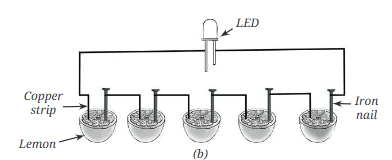 Electric Circuit using Lemons
Electric Circuit using Lemons
- The lemon juice acts as an electrolyte.
- Copper and iron are electrodes.
- Connecting several lemon cells in series can light up an LED.
- If the LED does not glow at first, reverse its connections (polarity matters!).
Dry Cell
The dry cell is the most commonly used battery in daily life (like in torches, clocks, TV remotes).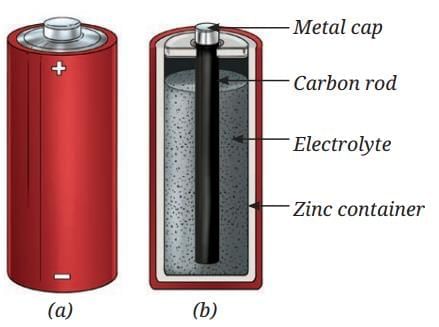 a) Dry Cell b) It's internal StructureIt is called "dry" because its electrolyte is not a liquid, but a moist paste.
a) Dry Cell b) It's internal StructureIt is called "dry" because its electrolyte is not a liquid, but a moist paste.
Structure:
- Zinc container (acts as the negative terminal)
- Carbon rod (positive terminal, at the center), surrounded by the paste
- A dry cell is usually single-use (not rechargeable)—once exhausted, it must be thrown away.
Rechargeable Batteries
Rechargeable batteries can be recharged and used many times (for example: in phones, laptops, cameras, vehicles).
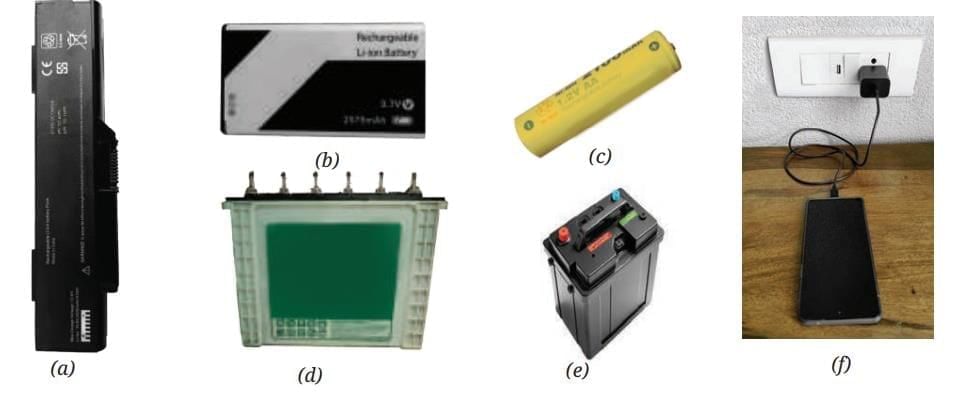 Rechargable Batteries
Rechargable Batteries
- They reduce waste and are more cost efficient over time.
- However, they also wear out after many cycles of charging and usage.
- Lithium-ion (Li-ion) batteries are the most common rechargeable batteries today—found in almost all modern devices.
- Scientists are working on solid-state batteries for the future, which will be safer, longer-lasting, and even more efficient.
Points to Remember: Electricity—Magnetic and Heating Effects
- Magnetic Effect of Electric Current: When electric current flows through a conductor (such as a wire), it produces a magnetic field around it. This is called the magnetic effect of electric current.
- Electromagnet: A coil of wire carrying electric current behaves like a magnet and is called an electromagnet. Most practical electromagnets have an iron core to increase their strength.
- Polarity: Electromagnets, like regular magnets, have two poles (North and South). The poles can be reversed by changing the direction of the current.
- Lifting Electromagnet: Powerful electromagnets are used in industries to lift and move heavy metal objects. They can be turned ON and OFF by controlling the flow of current.
- Heating Effect of Electric Current: When electric current flows through a conductor, it generates heat due to the resistance of the material. This is known as the heating effect of electric current.
- Heating Element: Devices such as electric heaters, irons, and kettles have a coil or rod made of high-resistance material (like nichrome) that acts as a heating element.
- Electric Cell and Battery: A cell or a battery generates electric current through chemical reactions occurring inside. Cells have a positive and a negative terminal.
- Dry Cell: A common type of battery used in daily life, containing a moist paste as electrolyte; generally single-use.
- Rechargeable Batteries: These batteries can be recharged and used multiple times, reducing waste. Examples include lithium-ion batteries used in phones and laptops.
- Electrolyte and Electrode: An electrolyte is a substance that conducts electricity by the movement of ions; electrodes are the metal terminals through which current enters or leaves a cell.
- Resistance: The opposition to the flow of electric current, leading to heating in wires or devices.
Electric current can create both magnetism and heat. Devices like electromagnets use the magnetic effect, while many household appliances use the heating effect. Batteries and cells are sources of electric current based on chemical reactions, and rechargeables allow repeated use, making them vital for modern life.
|
92 videos|296 docs|44 tests
|
FAQs on Electricity: Magnetic and Heating Effects Chapter Notes - Science Class 8
| 1. What is the relationship between electric current and magnetism? |  |
| 2. How can we observe the magnetic effect of electric current? |  |
| 3. Why does a current-carrying wire get hot? |  |
| 4. What factors affect the heating of a current-carrying wire? |  |
| 5. What safety precautions should be taken with current-carrying wires to prevent overheating? |  |

















